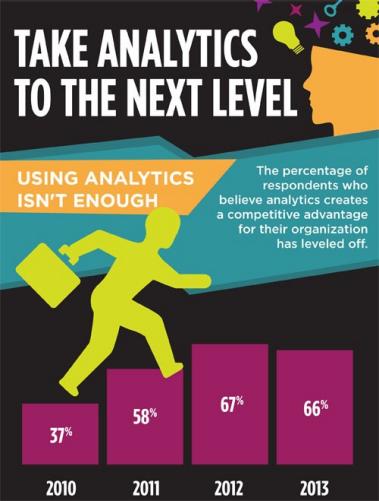Five questions to help bridge the analytics gap
By Pamela Prentice, Chief Research Officer, SAS
When Nate Silver accurately predicted the results of the 2012 presidential election in all 50 states, his status immediately rose to celebrity geek. Nearly two years on, Silver now runs a popular website (fivethirtyeight.com), which publishes data-driven reports on a range of topics from politics to sports. Certainly he is under intense pressure to stay relevant – and right. But with so much focus on data and analytics these days, it’s only a matter of time before someone else builds a better algorithm.
This holds true in the business arena as well. As big data takes center stage, analytics has become mainstream. What once provided a competitive advantage that had a huge payoff has now become table stakes. Indeed, it appears that the analytical advantage may have reached a point of inflection.
This data and analytics research by MIT Sloan Management Review and SAS suggests that the percentage of organizations gaining a competitive advantage through analytics has leveled off. In 2010, just over a third (37 percent) of companies reported achieving a competitive advantage with analytics, which soared to two-thirds (67 percent) by 2012. By 2013, the rate had leveled off at 66 percent. The implication? As more companies use their data to drive decisions, gaining and keeping an edge with analytics has become more challenging.
In light of this, nearly nine in 10 survey participants agree that it is important for their organizations to step up their use of analytics to make better decisions. Many are feeling the heat from senior management to become more data-driven and analytical. In a number of organizations, analytics is a top-down mandate from senior management.
In fact, culture – as measured by the behaviors, values and decision-making norms in an organization – plays a dominant role in in enabling organizations to achieve a competitive advantage with analytics. Of course, data management and analytics skills are essential. Successful analytics deployments require the right technology, data governance and dissemination as well as the right talent. But the linchpin that moves organizations from parity to competitive advantage is a strong analytics culture.
From the research, it is also evident is that organizations vary widely in their analytical sophistication. The 2013 report, From Value to Vision: Reimagining the Possible with Analytics, identified three distinct types of organizations:
- Analytically challenged.
- Analytical practitioners.
- Analytical innovators.
The third group, the analytical innovators, are those who report that innovation via analytics helped them gain a competitive advantage. As expected, these organizations differ significantly from their counterparts. Again, the key differences are related to culture.
Five questions (based on the survey results) are strong bellwethers for identifying where organizations are in their use of analytics. Analytical innovators were much more likely than their counterparts to give positive responses to the following:
- Is my organization open to new ideas that challenge current practice?
- Does my organization view data as a core asset?
- Is senior management focusing on making the organization more data-driven?
- Is my organization using analytical insights to guide strategy?
- Are we willing to let analytics help change the way we do business?
These five questions follow a natural progression. If an organization is not open to new ideas, it won’t be receptive to insights that differ from conventional wisdom. Companies must view data as a core asset in order to ensure that it is collected and managed in a way that makes it useful and credible. Data won’t affect strategy unless senior management views its company’s data assets and analytics skills as an important source of value and creates a data-driven environment. Finally, in order to gain or sustain an advantage through analytics, businesses must be willing to look at what they are currently doing and be willing change their course based on insight.
Organizations that are successful with analytics continue to invest in their analytical skills and technology to stay ahead of the competition. They must become adept at identifying the right data, asking the right questions and developing the right models. But they must also foster the right analytics culture, be open to new ways of thinking and change the way they do business. Achieving and sustaining competitive momentum is hard work. Ask Nate Silver.
Pamela Prentice is SAS' chief researcher, with more than 30 years of experience in the market research field. Her background includes consumer and business research for large businesses and 10 years as an academic, with a focus on teaching market research and consumer behavior. Prentice has been with SAS since 2000, and in her current role, she uses SAS software to derive insights from customer and market data to understand how businesses are using technology.

Read More
- Want to know more about of the global executive study and research on data and analytics? Download The Analytics Mandate to better understand how organizations are changing their decision making, operations and strategies.
- Return to Analytics Insights.

